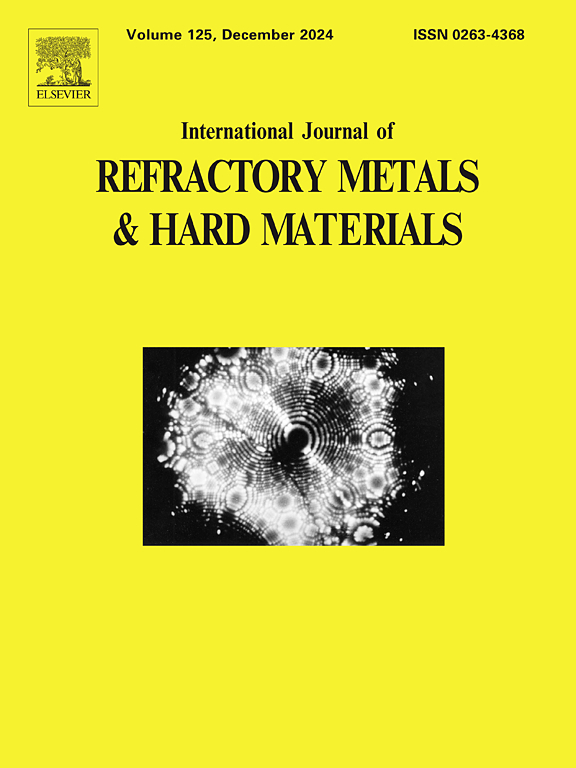基于价电子密度的超高温(Ti1-xNbx)C固溶体的温度依赖性质
IF 4.2
2区 材料科学
Q2 MATERIALS SCIENCE, MULTIDISCIPLINARY
International Journal of Refractory Metals & Hard Materials
Pub Date : 2025-04-09
DOI:10.1016/j.ijrmhm.2025.107183
引用次数: 0
摘要
为了了解对极端环境应用至关重要的超高温材料的机械、热和化学特性,本研究对基于价电子密度的超高温(Ti1-xNbx)C 随温度变化的特性进行了研究。结果表明,(Ti1-xNbx)C 随温度变化的功函数、热电子发射和电阻率受自由价电子密度的支配。与温度相关的(Ti1-xNbx)C 体积模量、固溶强化或软化、熔点温度则由平均局部价电子密度主导。此外,在脆性到韧性(BTD)温度之上,由于位错运动是由扭结原子传播介导的,(Ti1-xNbx)C 在高温下的热硬度是由扭结原子(即碳原子)上的局部价电子密度主导的。基于价电子密度的(Ti1-xNbx)C 随温度变化的特性将为以性能为导向的先进超高温材料设计铺平道路,在这种材料中,可以在电子尺度上合理定制优化的机械、热和化学特性。本文章由计算机程序翻译,如有差异,请以英文原文为准。

Valence electron density based temperature-dependent properties of ultra-high temperature (Ti1-xNbx)C solid solutions
In order to understand the mechanical, thermal and chemical properties of ultra-high temperature materials, which are crucial for the extreme environment applications, the valence electron density based temperature-dependent properties of ultra-high temperature (Ti1-xNbx)C have been investigated in this study. The obtained results demonstrated that the temperature-dependent work function, thermionic emission, electrical resistivity of (Ti1-xNbx)C were dominated by the free valence electron density. The temperature-dependent bulk modulus, solid solution strengthening or softening, melting point temperature of (Ti1-xNbx)C were dominated by the average localized valence electron density. Moreover, above the brittle-to-ductile (BTD) temperature, due to the fact that dislocation motion is mediated by the kink atom propagation, the hot hardness of (Ti1-xNbx)C at high temperature was dominated by the localized valence electron density on the kink atoms, i.e. carbon atoms. The valence electron density based temperature-dependent properties of (Ti1-xNbx)C, will pave the way towards the performance-oriented design of advanced ultra-high temperature materials, where the optimized mechanical, thermal and chemical properties can be rationally tailored at electronic scale.
求助全文
通过发布文献求助,成功后即可免费获取论文全文。
去求助
来源期刊
CiteScore
7.00
自引率
13.90%
发文量
236
审稿时长
35 days
期刊介绍:
The International Journal of Refractory Metals and Hard Materials (IJRMHM) publishes original research articles concerned with all aspects of refractory metals and hard materials. Refractory metals are defined as metals with melting points higher than 1800 °C. These are tungsten, molybdenum, chromium, tantalum, niobium, hafnium, and rhenium, as well as many compounds and alloys based thereupon. Hard materials that are included in the scope of this journal are defined as materials with hardness values higher than 1000 kg/mm2, primarily intended for applications as manufacturing tools or wear resistant components in mechanical systems. Thus they encompass carbides, nitrides and borides of metals, and related compounds. A special focus of this journal is put on the family of hardmetals, which is also known as cemented tungsten carbide, and cermets which are based on titanium carbide and carbonitrides with or without a metal binder. Ceramics and superhard materials including diamond and cubic boron nitride may also be accepted provided the subject material is presented as hard materials as defined above.

 求助内容:
求助内容: 应助结果提醒方式:
应助结果提醒方式:


